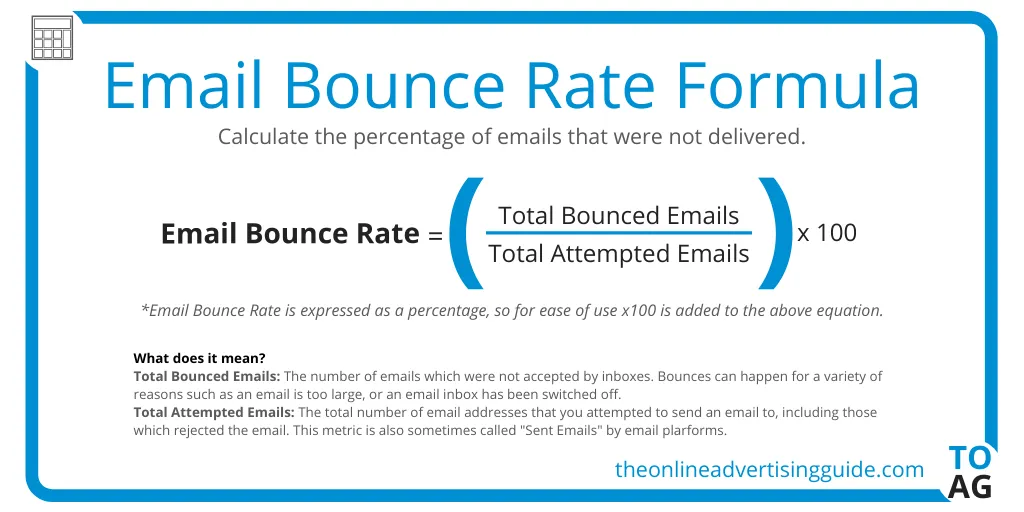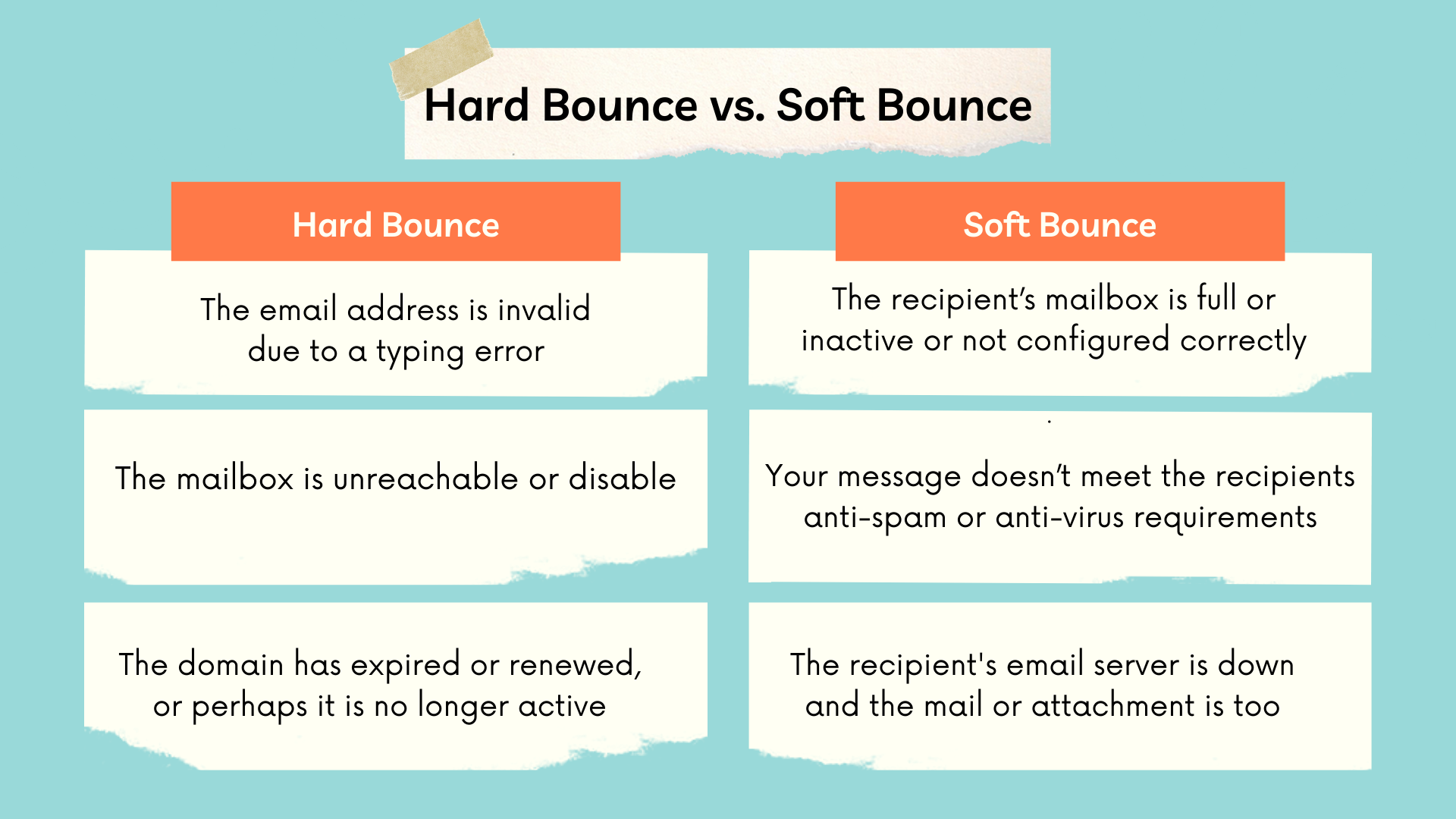One of the most important metrics to track is the average email bounce rate. If an email bounces, it means that it never came through. And customers can’t respond to emails they don’t receive.
What is perhaps even worse, bounced emails hurt your email domain reputation.
Today, we’re going to show you what email bounce rate is, what a good value is to aim for and how you can lower your bounce rate with ease.
What is the average email bounce rate?
Email bounce rate is the percentage of addresses in an email list that didn’t receive an email because the recipient’s mail server returned it.

In other words, an email bounce means it can’t be delivered to its intended recipient. The bounce rate is essentially the percentage of emails that did not make it to where they were meant to.

An email bounces for all sorts of reasons. A soft bounce is a temporary problem, whereas a hard bounce is permanent. You need to strip out them straight away as they may result in a permanent delivery failure. A soft bounce is one you should monitor.
Here is everything you need to know about the different types of email bounces.
Soft bounces
A soft bounce is the better version of a problem that you can have. Here are some reasons why an email might get a soft bounce:
- The recipient’s inbox is full
- The message size is too large for the email server
- Your domain was blocked
- The message content is rich with spam terms (that are triggering the SPAM filters) or an overly-heavy ratio of images to text
What’s in common with all these situations is that they are temporary issues that are hurting your email delivery. You cannot influence them and after a certain period of time, they will no longer be a problem.
Hard bounces
This is the worse of the two possibilities with an email bounce. Here are some reasons why you might get a hard bounce when sending an email:
- Expired or invalid addresses /email accounts
- No mail server for the address
- Incorrectly typed or supplied email
The difference here is that the culprit for the hard bounce is you, the sender. By ensuring you’re sending to a valid email address, you can avoid these technical issues easily. If you have a lot of hard bounces for a longer time period, you can seriously hurt your email sender reputation.
Need more information? Check out Q&A: email bounce backs, and a detailed comparison of soft bounces vs hard bounces.
What is an acceptable average email bounce rate?
Bounce rates aren’t a one-size-fits-all problem. Different industries have different acceptable email bounce rates. So, looking at the topic in general terms, what is an acceptable bounce rate for emails?
If your bounce rates are under 2%, whatever field you operate in, that’s okay. Keep doing what you’re doing, but don’t get complacent. Low bounce rates can change at any point. Vigilance is key to keeping hold of those healthy figures.
If your bounce rate is over 2%, you need to take a look at why, and the best way to fix it.
In most cases, bounce rates approaching 5% require serious action.
If they’re as high as 10%, then it’s time to instigate a full-blown plan of attack. You need to turn things around and get those rates back to where they should be so your next email message lands where it should.
Average email bounce rate for email campaigns
We looked at two major industry players to try and confirm a good email bounce rate benchmark.
Mailchimp average email bounce rate
This company released statistics from campaigns during 2019 with over 1,000 subscribers. The campaigns were delivered throughout a range of industries, revealing the average email bounce rate (soft and hard) as well as open and click rates.
The campaigns were delivered by businesses right across the board—from single-person start-ups to Fortune 500 companies.
- The average hard bounce came in at 0.4%
- The lowest hard bounce was 0.25% in religion, closely followed by e-commerce at 0.27%.
- The highest hard bounce was 0.86% in construction, and in second place, insurance with 0.72%.
- The average soft bounce was 0.58%.
Email Campaign Monitor average email bounce rate
This company analyzed over 30 billion marketing emails sent across the globe throughout 2019. They found a total average bounce rate of 0.7% with the same size of fluctuation between industries.
The key takeaway marketing tools noticed was how much the figures are improving each year. This shows the importance placed on high-quality lists and the effort made by marketers to attain them.
How to prevent high bounce rates
When creating an email marketing campaign, you need to consider the best way to reduce your email bounce rate, prevent hard and soft bounces, spam complaints, and engage your active subscribers.
There are plenty of measures you can take to clean your lists and reduce problem numbers. Here’s a list of the procedures you should be carrying out already—and not just when a bounce occurs, and the bad bounce rates start to appear.
Clean your lists
Using an email checker (like Bouncer!) to clean your lists on a regular basis is a must. It’s easy to do and guaranteed to clear out the addresses that would bounce before they can do any damage and reduce the bounce rate, leaving only the valid email addresses on your list.
The first step to decrease a high email bounce rate and solve your bounce rate issues is to remove invalid email addresses from your email lists. Reduce your email bounce and prevent a permanent failure while sending emails by cleaning your email list regularly.
It’s as easy as creating a free Bouncer account! Just copy and paste your list of subscribers and you’ll get a list of the emails that are going to cause problems with your email deliverability.
Simply remove them and the next time you send an email, watch your bounce rate drop.
Use double opt-in and permission-based email marketing
A double opt-in (one where the recipient has to confirm they chose to be added to a list) will help to filter out fake signup forms and misspelled email addresses. Simply put, a customer receives a confirmation email first before they can start receiving more emails.
On the other hand, single opt-in means that as soon as they enter their email, they are added to your list.
A purchased email list is always a bad idea. You have no idea if the recipients are interested in your product or service, so your emails get into the spam folder. There’s also a chance that your new email list is full of broken addresses.
Do yourself a favor; gather your marketing data correctly. Give yourself the best chance of a healthy email list and just as healthy returns by using a double opt-in option.
Authenticate your emails to improve average email bounce rate
Authenticating your email signature in your email campaign settings is one more technical step to add credibility to your email deliverability.
Don’t send emails from free email domains
As much as Gmail, Yahoo, Hotmail and a host of other free email services are generally trustworthy email service providers, sending emails from their addresses will often fail DMARC checks and be bounced back or sent straight to their junk folder.
Send your email campaigns from your sending domain, and maintain as high a domain reputation as possible at all times. Use your preferred email tool and a specialized domain to reduce the chances of different types of bounces.
Send quality emails to boost average email bounce rate
Email filters monitor messages and email subject line for phrases that are typically associated with spam emails. Run a spam check on your email content before delivery to check the content and score of your email.
Only ever send out professional-quality emails. Include your correct contact and official information, and always include an unsubscribe option.
Send emails consistently and frequently
Sending out regular emails will help filter your contacts at a steady, manageable pace. Emailing campaigns twice a month is a fair rate for a typical business.
If your company delivers relevant and current information that customers are hungry for, then you can send them multiple times each week. It’s essential to understand which is right for you and never to over-send, annoying your recipients.
Regular delivery gives you a chance to monitor campaigns steadily, keeping your bounce rate low. If you only send twice a year, the number of expired addresses will have grown significantly, resulting in much higher bounce rates impacting your sender reputation. Worth noting is also your open rates, meaning the percentage of the emails that get opened after you send campaigns.
Confirm engagement and remove inactive subscribers
Checking that your information is relevant and of interest to your recipients is good practice.
Those who have changed jobs, lost interest in a pastime, or no longer require your service or product could be hitting the spam or delete button every time your email lands. That will have a negative impact on your domain.
It’s better to weed out a bad address than keep the email marketing strategy to an email list full of outdated leads.
Monitor the bounce rates of every campaign to improve average email bounce rate
You should be doing this already, as your average bounce rate for email campaigns can vary week-to-week.
Monitoring all of your results (not just the click-throughs and conversions) is a must. The bad results tell you just as much as the good ones. You should be removing all the hard email bounces as soon as you detect them.
In order to maintain a good email bounce rate for a long period, in the first place, you should consider cleaning your contact list regularly and removing invalid emails to keep a high data quality. Keep a clean list, and its quality will improve consistently.
Improve your average email bounce rate!
Staying on top of your bounce rate is not something that is just nice to do – it’s essential if you want to succeed in your email marketing efforts. Leaving your email bounce rate unattended can seriously harm your email marketing and overall marketing efforts.
Luckily, we have just what the doctor ordered. Bouncer helps you keep your subscriber lists pristine – just run your email lists through our tool and in minutes, you’ll know exactly which emails to remove. We’ll show you all the outdated and invalid addresses so you can remove them and only reach out to real people.
Use Bouncer and say goodbye to high bounce rates. Sign up today for your free trial!
Average email bounce rate: frequently asked questions
What is a good bounce rate?
It depends on your industry. However, any bounce rate that is lower than 2% should be considered a great result.
What is a good way to fix my bounce rate?
The first thing to do is use double opt-in for your subscriber forms. The second thing to do is use a email validation service such as Bouncer to clean up and validate your existing list. This will help you remove old and outdated addresses.
Do incorrect emails always bounce?
In short, yes. Even if you misspell a single letter in an email address, the email you send out will bounce. This is why it’s crucial to validate your lists, as misspelled emails are removed immediately.


